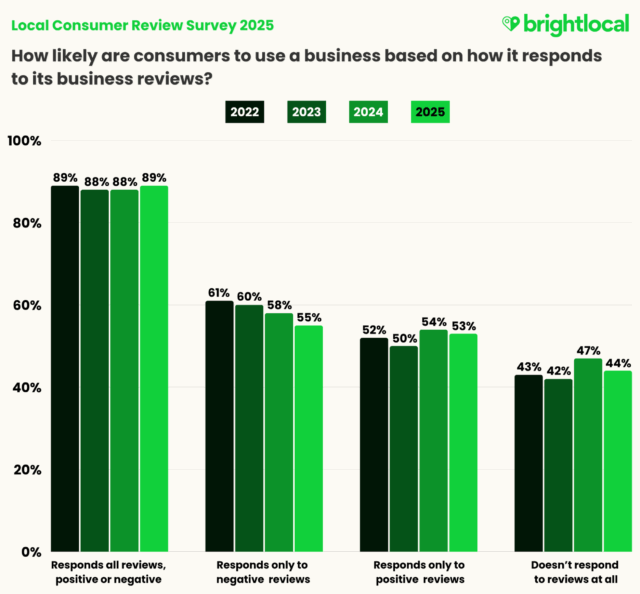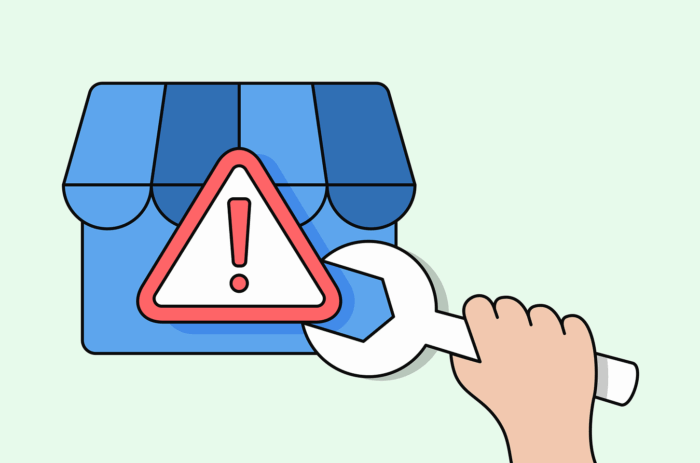Just when you’re getting to grips with one area of local marketing, another conundrum comes along. Is it something you’ve done wrong, or because of something you haven’t done at all?
We’ve previously talked about the changing nature of SEO, and how that means some tactics can become outdated or even no longer seen as best practice. Combine that with some of the, um, questionable advice that can sometimes be found online, and you can find yourself in a bit of a pickle.
Mistakes happen, but some can be more costly than others. If your business no longer ranks in the local map pack or organic results, that’s a problem because it means prospective customers aren’t able to find you. If you’ve recently received several negative reviews and didn’t respond to them in the hope the issue might go away, that’s a problem because it’s going to affect the way consumers perceive your business.
Understanding the consequences of mistakes and missed opportunities can help you make sure they don’t happen. And if they do? We’ve gathered some of the biggest local SEO mistakes from our industry friends, and shared their fixes here with you.
The biggest local SEO mistakes:
- Not having a website
- Not claiming a Google Business Profile
- Picking the wrong Google Business Profile categories
- Immediately changing GBP details as soon as you’re verified or unsuspended
- Not adding enough videos or photos
- Poor image quality on uploaded GBP assets
- Ignoring what competitors are doing and looking at your own business in isolation
- Concentrating too much on Google Business Profile and ignoring other owned channels
- Replying badly to negative reviews
- Simply not responding to any reviews at all
Not investing in the right platforms
It may come as a surprise, but the biggest mistake could be simple inactivity.
In August 2025, we surveyed 778 SMB owners and managers. While 72% of them said that SEO had a medium-high impact on their business, the reality of their tactics highlighted some serious mistakes.
- 40% said they have a dedicated website.
- 35% of SMBs have Google Business Profiles.
So before we get into the specific mistakes that experts often see across these platforms, it’s worth knowing that the biggest mistake of all is not being present in the first place. A Google Business Profile and a website are basic foundations for ranking and interacting with your customers.
The good news is these mistakes are simple to fix, and we can help. Read our guides on creating a Google Business Profile (they’re free, and simple to claim), and our step-by-step advice on creating a website from scratch.
Google Business Profile mistakes
There are many mistakes you can make with a Google Business Profile (GBP) beyond being among the two-thirds of businesses that don’t have one. If you are, quickly go and claim one now. Read on for tips to help you avoid a profile suspension and find out why adding secondary categories is more than just a tick-box exercise.
When setting up or managing your GBP, you’re given the option to choose one primary category and up to nine additional ones. Sounds simple enough, but this is hands down one of the most common (and costly) mistakes I see across the wide range of clients I work with, no matter the industry.
Correctly chosen categories help your listing show up in the right local searches. But get them wrong, or worse, leave out relevant ones, and you’re practically handing over visibility to your competitors.
Take a recent example: I was reviewing a client’s GBP who specialises in boots and shoes. They hadn’t selected either “Boot shop” or “Shoe shop” as a category. Instead, they’d gone with something vague and less helpful. No wonder they were struggling to rank for the terms that actually mattered to them.
And it’s not just about visibility, it’s about instilling confidence in potential customers. Even if your profile does rank, having a broad primary category like “Clinic” while your competitors are listed as “Physiotherapy clinic” or “Chiropractor” can make you seem like a less relevant choice. Someone looking for a specific service is much more likely to click on the profile that spells it out clearly.
In multi-practitioner scenarios, think doctors, therapists, or dentists, shared primary categories across all profiles can even result in a practitioner profile outranking the main business listing. One way around this is to diversify categories across listings to protect your brand’s presence in local results.
Don’t set and forget!
“Categories aren’t a tick-box exercise you do once and never revisit. Google updates its categories all the time. New ones get added, names get tweaked, and if your business offering evolves, your categories should too.
On top of that, Google can override what you’ve set if it finds conflicting information elsewhere or receives enough suggested edits. It’s worth building a regular check-in into your local SEO routine to make sure your GBP is still aligned with what you actually offer.”
I see it time and time again: a merchant gets unsuspended or verified, and they immediately do things like change their business name or add or remove an address. This can trigger another verification process and usually a suspension.
Another big thing I see is with profile suspensions in particular. The situation usually unfolds like this: the merchant is suspended and they do not read the appeal screen properly and rush through the process. They will ignore the section for adding proof or forget about it. Then, after the appeal is denied, they rush through the review process. These are your two chances to appeal, so don’t waste them.
Missed opportunities for content
Many business owners don’t realize the opportunities that posting their own photos, videos and posts to GBP presents. As Claudia Tomina explains below, it’s now more important than ever.
One of the most common mistakes I see in local SEO is the lack of content. Specifically, not generating enough photos and videos. These aren’t just nice-to-haves anymore; they’re ranking signals. Google now uses visual content to extract context, keywords, and relevance, so when businesses neglect this area, they’re missing a major opportunity to improve visibility.
The fix? Stop overthinking it and start recording. For service-based businesses like plumbers, contractors, or restoration teams, the job site is your content studio. Capture before-and-after photos, record quick videos explaining what was done, and upload consistently.
You don’t need to be a polished presenter, authenticity will resonate. Over time, this habit will build trust with potential customers and strengthen your brand presence across search.
For Mike Blumenthal, one of the biggest local SEO mistakes is:
Using stock photography. Hire a professional photographer for a day to upgrade the quality of the images uploaded to GBP.
Not carrying out competitor research
Local-level competitor research may seem like a ‘nice to have,’ but if you aren’t monitoring your closest competitors then you could be harming your own visibility without even realizing. Amsive’s Bambi Frazier explains in more detail below.
One of the biggest mistakes I see is skipping competitor research at the local level. Too often, people think they know what’s holding them back, when in reality, it’s their top competitors simply executing better at the local level. Local SEO isn’t a “one-size-fits-all” strategy. What works in one location may not be what’s needed to help another location succeed. Understanding how and why your competitors are outranking you at the local level is crucial to developing a more innovative and effective Local SEO strategy.
Start by analyzing your top local competitors (hint: it’s typically the ones outranking you in the Local Map Pack). Dive deep into their Google Business Profiles and use browser extensions and SEO tools with AI features to help make the discovery process more efficient.
- Look at all the GBP categories they’ve selected, not just the Primary category.
- Do they have more reviews?
- Are those reviews more recent and more detailed?
- Are they responding to their reviews?
- Do they have a variety of real-world images (staff, equipment, services, customer waiting areas)?
- What queries are triggering justifications to show in the Local Pack?
Going beyond Google Business Profile
“Audit your competitor’s websites with a sharp focus on their service area pages and location pages.
- Do they have hyper-local content on those pages?
- Does their content structure follow SEO best practices?
- Do those pages have structured data?
- What other elements on those pages are increasing their online visibility?
Spot your competitor’s gaps on GBP and on their website to capitalize on them. And whatever they’re doing right: do it better.
The goal isn’t to copy them; it’s to outperform them at every turn, with sharper strategy, better execution, and a relentless focus on what works for each of your locations individually, at the local level.”
Review management missteps
We’ve all seen funny examples of negative business reviews with sarcastic owner responses. But in reality, this response sentiment can be a detriment to the brand and how others perceive it. And not responding to reviews at all? Customers do notice.
It might not be the most common mistake, but it’s a big one in terms of the damage it can do to your business. And yet, so many business owners don’t realise they shouldn’t do this: replying poorly to negative Google reviews. By that, I mean responding in an argumentative, sarcastic, or generally unpleasant tone. It immediately makes the review look worse. No matter who’s ‘right’, it’s always a bad look for the business.
To fix this, my best advice is: don’t reply right away. Give yourself time to cool off, then come back and respond professionally. A reply that shows empathy and a genuine desire to make things right goes a long way. Every business gets bad reviews, people these days expect that. What matters is how the business responds to those reviews, both online and in how they change their business in response to real critiques. That’s what potential customers will remember.
“The best defence to negative reviews? Do great work, keep your customers happy, and ask for reviews when the job’s well done. That way, you can let your happy customers do the talking.”
Not responding to business reviews. Business owners or managers should respond to all reviews to address concerns, appreciate those who wrote reviews and demonstrate general engagement and responsiveness. This will help with consumer perceptions of the business and may indirectly help with local visibility.
Responding to all of your business reviews
The 2025 Local Consumer Review Survey found that 89% of consumers would use a local business that responds to both positive and negative reviews.

Hopefully, these mistakes and missed opportunities have given you some food for thought, and something to keep front of mind as you navigate the realms of local marketing. But if you feel that these have simply added to your never-ending list of things to do, you might also want to consider how fully managed local SEO services could help you.








